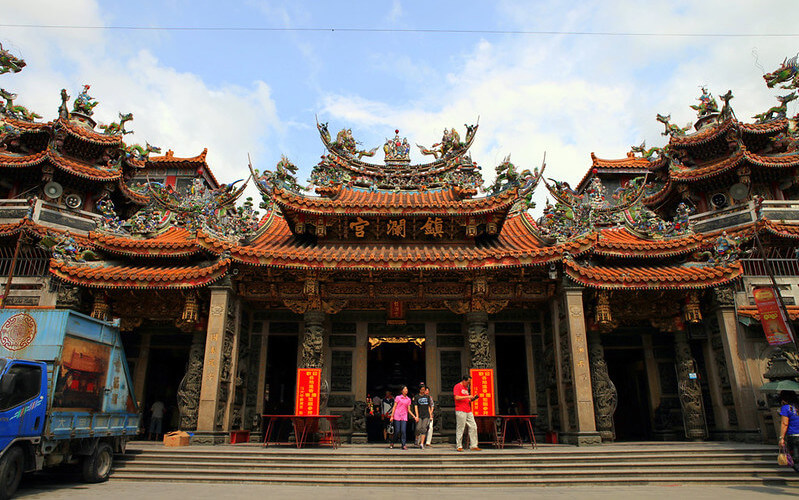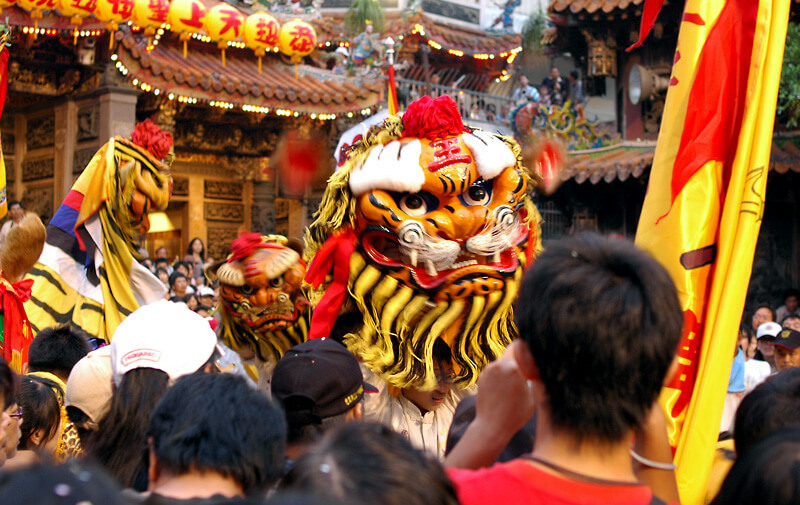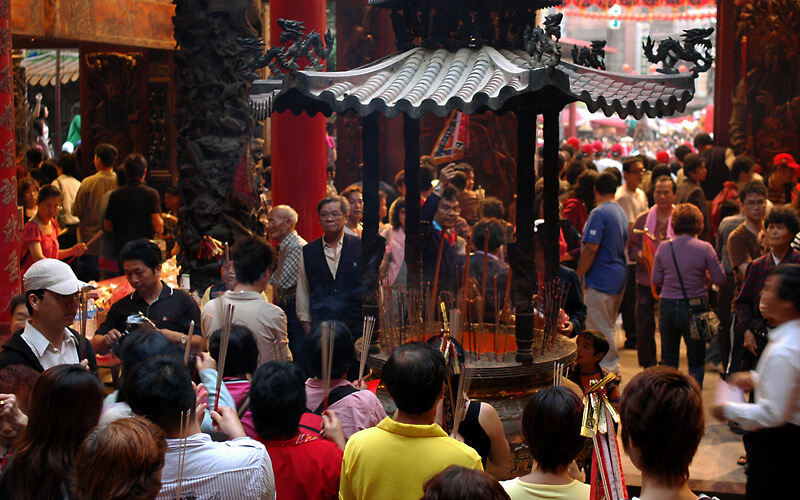With its cracking fireworks, ornate sedan chairs, and millions of devotees, the Dajia Mazu Pilgrimage (大甲媽祖繞境) is one of Taiwan’s most remarkable religious events. Held annually on the third month of the lunar calendar (around March or April), the nine-day, eight-night procession covers some 340 kilometers from Jenn Lann Temple in Dajia Taichung to Fengtian Temple in Chiayi, passing around over 100 temples along the way — all for the sea goddess Mazu, one of the most celebrated deities in Taiwanese Taoism.
Given that there are an estimated 3,000 temples dedicated to Mazu across the country, the pilgrimage’s significance is hard to overstate. If you’re curious about joining the procession, read on to get clued in about this vibrant Taiwanese tradition.
1. It’s essentially a giant early birthday party
Though the exact dates of the pilgrimage vary from year to year, they always precede the traditional birthday of the goddess Mazu.
Mazu, a semi-historical figure, was a powerful shamaness believed to have lived during the 10th century on Meizhou Island, just off the coast of southeast China. Various Taoist stories tell of her being able to see into the future, heal the sick, and appear to people in visions. By some accounts, she ascended to heaven in a beam of light after her brother was lost at sea, and over the following centuries became venerated as a protector of fishermen and sailors. When the coastal people of southeast China migrated to Taiwan in the 17th century, Mazu worship came with them.
2. It’s almost 300 years old
The Dajia Mazu Pilgrimage dates back to 1730 when a man named Lin Yongxing migrated from Meizhou to the village of Dajia (an easy 40-minute trip out of Taichung) bringing with him a statue of Mazu from the goddess’s original temple.

According to traditional Chinese folk religion, religious statues have to be brought back to their place of origin periodically to recharge their spiritual energy. The pilgrimage originally went between Taiwan and China as a way of fulfilling this important ritual.
When Japan took over Taiwan in 1895 and travel to China became impossible, devotees did the next best thing: taking the statue on tour around other venerable temples around Taiwan.
3. The pilgrimage dates are determined by an ancient form of divination
Given what an auspicious occasion it is in Taiwanese Taoism, there’s really only one person who can decide when to hold the Dajia Mazu Pilgrimage: Mazu herself. Every year on the day of the Lantern Festival, head priests at the Jenn Lann Temple use an ancient form of divination, known in Taiwanese as bwah-bweh (筊杯) to ask the goddess when the procession should take place.

If you’ve ever wandered around a Taiwanese temple, you may have heard the clatter of this ancient ritual. Devotees ask a question before a deity with two moon-shaped wooden blocks on their hands, before tossing them to the ground. The block’s position is what allows them to determine the god’s reply: yes, no, or ask again.
This year, the procession is slated to run from April 8 to April 17 when it will return to Jenn Lann, though in some years the procession has ended as early as March 29.
4. You won’t go hungry
No one wants to walk 340km on an empty stomach, but fortunately, you’re unlikely to face that particular predicament. For those who don’t walk with the procession, it’s considered good form to honor Mazu by providing food and necessities for passing pilgrims.
Along the itinerary, crowds of onlookers hand out snacks to anyone who is hungry — all of which is vegetarian as Mazu pilgrims are not supposed to eat meat. Much of the handouts are produced locally. Expect lots of watermelon and corn on the cob in Yunlin — and don’t be surprised if you’re handed a pair of socks or an umbrella in Changhua (a manufacturing hub). If you’re lucky, you might also be offered fistfuls of shuirunbing (水潤餅) a sweetish Hsinchu flatbread often given out to Taiwanese pilgrims.
Temples visited by the statue will also provide free food. Just make sure you get there before the statue itself arrives. Many temples will clear away the free grub as soon as Mazu is gone.
5. You’ll need to book your accommodation well in advance
If you enjoy a certain level of comfort on the road, then you’ll want to find a place to stay well in advance. The Dajia Mazu Pilgrimage runs through some fairly rural parts of central Taiwan, and while there are guest houses along much of the route, there aren’t enough beds to accommodate the thousands that will be passing through on any given day.
If you can’t find a place to stay, the temples are fair game. Though it’s worth noting that in previous years it’s been recommended that pilgrims arrive a good few hours before Mazu if they want anything resembling a decent sleep.
6. You’ll be lucky if you can get run over
Most years on the Dajia Mazu Pilgrimage it’s common to see devotees kneel face down in the middle of the road so that Mazu’s sedan chair can pass over them. “The Kneeling Ritual” (鑽轎腳) dates back centuries in Mazu worship and is performed across Taiwan, though it’s most commonly associated with the Dajia pilgrimage.
It’s believed that when the goddess’s sedan passes over you, you receive Mazu’s blessings and protection. There are few taboos associated with the ritual though devotees should take off their hats and any lucky charms that they may be wearing. Otherwise, it’s also considered good luck to help carry Mazu’s sedan or to shelter her from the sun with an umbrella.
Both rituals draw large crowds of followers during the procession, though in 2021 they were banned due to the pandemic.
7. And you might see a couple of fights
Auspicious a deity as she is, Mazu has a bit of a reputation for causing scuffles when she is out on tour. As only a handful of venerable temples are visited on the pilgrimage itinerary, it’s common for those left out to attempt to force the procession to detour. Though these are normally good-natured, there are times that fights can break out between temple followers.

Moreover, lesser temples may try to steal the statue’s spiritual powers by surrounding the procession with flag banners and religious talismans. This is just one reason why nowadays, whenever Mazu travels a security detail of police officers is not too far behind.
8. But it also might be the Taiwanesiest thing you can do this year
While religious processions elsewhere in the world might have dwindled in size over past decades, Mazu’s cult is actually growing in Taiwan — and rapidly. Over 930,000 people attended in 2009 and by 2021, that number was estimated to have surpassed 4 million.
Some attribute this to Mazu’s growing importance as a symbol of Taiwanese nationalism, as the pilgrimage really began to swell in size after Taiwan democratized in the 1990s. Mazu and other folk gods like her are seen as a distinguishing cultural tradition between Taiwan and China, where their importance has faded from daily life. And though you’ll encounter similar processions around the year and across the country, few take place on quite the same scale and volume.
Cover photo: Flickr/Chi-Hung Lin












